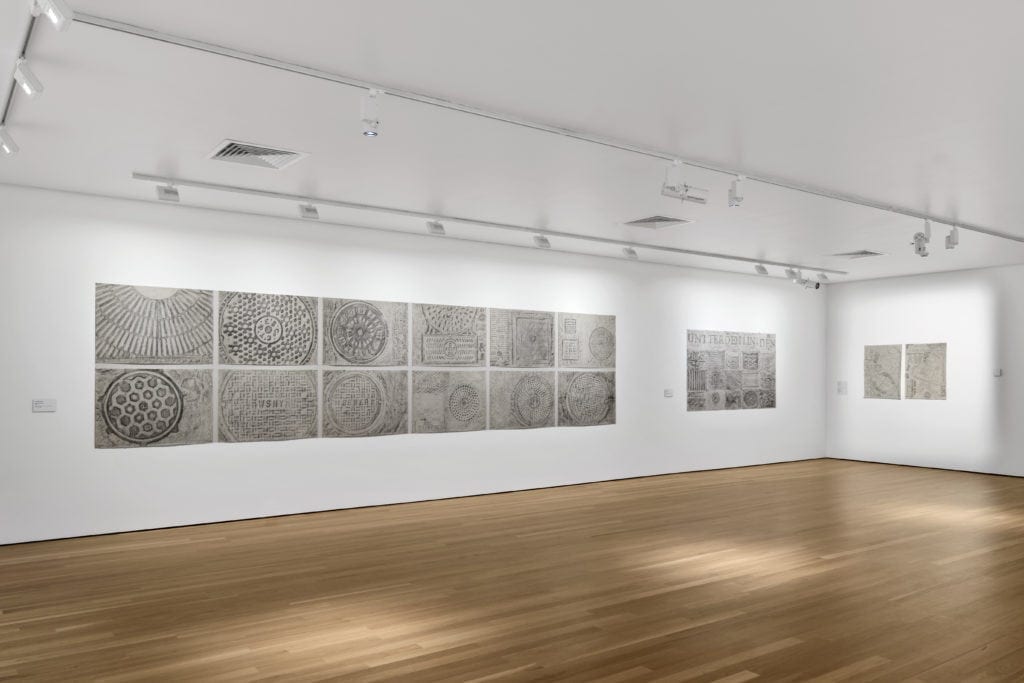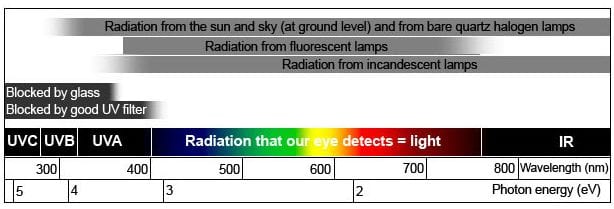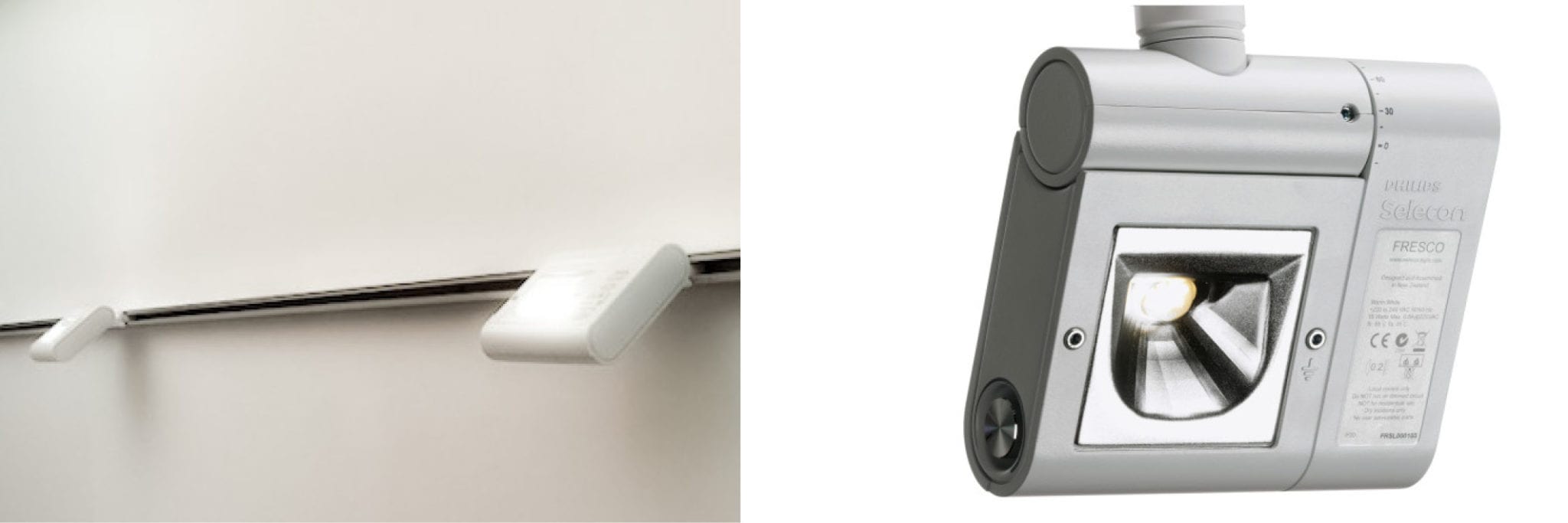
Image credit: Exhibition documentation showing gallery lighting tracks, Richard Tipping: Art Word, 21 July to 21 October 2018, Gallery 4. Latrobe Regional Gallery.

Image credit: Example of a lux meter. Latrobe Regional Gallery.

Image credit: Diagram outlining the wavelengths and energy of different types of light. Latrobe Regional Gallery.

Image credit: Lighting track with wash lights illuminating walls, and close up of Philips selecon fresco LED wall washer. Latrobe Regional Gallery.

Image credit: Lighting track with canon lights focused on artworks, and Philips selecon LED spot lighting. Latrobe Regional Gallery

Image credit: Lighting track control panel. Latrobe Regional Gallery.
LRG EDUCATION
Preventative Conservation: Light Damage
VCE Studio Arts Unit 4 Area of Study 3: Art industry contexts
♦♦♦
LIGHT DAMAGE
Visible light is a small part of the light spectrum which is essential for viewing almost all visual art. Light deteriorates most works of art and cause objects to fade, discolour or can accelerate the deterioration of some materials from both the intensity of light and also the length of time an object is exposed to light. Light sources contain varying visible, ultraviolet (UV) or infrared (IR) damage, which is cumulative and irreversible to light-sensitive objects, and require displaying artworks at reduced light levels, however, low light levels over a long period of time can cause degradation equal to or even greater than intense light for a short period. Light near artworks should always be carefully monitored and limited by using indirect positioning of light sources and lux level monitoring.
Ultraviolet rays, found in sunlight and fluorescent lighting, is the most active and damaging part of the spectrum. UV has a shorter wavelength that creates a photochemical reaction and changes at the molecular level, so should be filtered and eliminated as much as possible to prevent damage. UV damage can include colour fading, yellowing, and embrittlement.
The longer wavelength, infrared (IR), is present in both sunlight and tungsten light, and is a source of heat, posing another form of danger. Radiant heat may cause a reaction on the surface of an object, such as cracking, blistering, burning, lifting, and discolouration.
As LRG is located in the old Morwell Town Hall, extensive renovations to the building over many years were necessary in order to omit all windows and limit any light leaks around doorways near all gallery and collection storage spaces. The windows in the main foyer area are also coated in a double-glazing film which eliminates UV light leaking in to Gallery 1 & 2. The windows and doors leading out to the Sculpture Courtyard in Gallery 3 have also been covered in an opaque film, and additional roller blinds are in place for additional protection.
LUX AND LUMENS
Lux is the internationally recognised unit of light energy. Light and UV levels for exhibitions and the collection storage spaces are able to be monitored with a special light meter or ‘luxometer’ which measures light energy in lux. Lux (lumen/square metre) is a measurement of light, with 1 lux = 1 candle light. Ultraviolet light (UV) is measured in microwatts per lumen (µw/lumen).
GUIDELINES FOR LIGHTING LEVELS
Guidelines from ReCollections indicate that UV levels and length of exposure to light for materials of different sensitivities:
HIGHLY SENSITIVE MATERIALS
Note: Sensitive materials include items such as textiles, works on paper, photographs, watercolours, some plastics, and some mixed media works.
- The brightness of the light should be no greater than 50 lux.
- The exposure in one year should be no greater than 200 kilolux hours.
- The UV content of the light on sensitive materials should be no greater than 75 μW/lm—microwatts per lumen—and preferably below 30 μW/lm.
MODERATELY SENSITIVE MATERIALS
Note: Moderately sensitive materials include items such as oil and acrylic paintings, wood sculpture and furniture.
- The brightness of the light should be no greater than 250 lux.
- The exposure in one year should be no greater than 650 kilolux hours.
- The UV content of the light should be no greater than 75 μW/lm—microwatts per lumen—and preferably below 30 μW/lm.
NON-SENSITIVE MATERIALS
Note: Non-sensitive materials include items such as glass, marble, ceramic, stone and metal.
- Objects that are not particularly sensitive to light should still be protected.
- Do not unnecessarily expose them to very high lighting or UV levels.
Remember also that many objects are made from composite materials and may contain small amounts of sensitive materials.
Works of art which are highly sensitive are carefully monitored so that they spend some time ‘resting’ in darkened storage away from the damaging effects of light. This does not repair deterioration but it prolongs the life of the work of art by preventing further damage. The ratio generally applied to display and storage time is 1:3. This means that if a drawing is on display for one month it should be stored for three months.
LRG cannot completely eliminate the deterioration of works of art from light exposure, rather we manage and limit the rate of deterioration. Ideally the best way to preserve sensitive and moderately sensitive categories of art is never to exhibit them, however this would defeat the purpose of housing a collection of art which was created with the intention to be viewed. The use of flash photography is not allowed in LRG’s exhibition spaces to protect artwork from the bright light and to avoid copyright infringement.
ARTIFICIAL LIGHT SOURCES
According to ReCollections there are many types of artificial light sources. Each has advantages and disadvantages:
- Incandescent tungsten lamps, in spot or floodlights, have a low UV output, but emit infrared radiation in the form of heat. Therefore, if they are close to items or placed in a closed case, they can cause damage by raising the temperature of the objects;
- Fluorescent light tubes are cold, but many emit higher than acceptable levels of UV radiation. However, fluorescent tubes are generally favoured, because they are more cost-effective to run and are longer-lasting than incandescent bulbs; and
- Tungsten halide bulbs, which are more efficient than ordinary incandescent bulbs, also give out higher than acceptable levels of UV.
In considering appropriate levels of lighting, take into account the following factors:
- How sensitive the materials are to damage by visible light and UV radiation; and
- The activities that take place in the area being considered.
Keep in mind that the amount of damage caused by photochemical reactions depends on the energy of the radiation as well as the amount of radiation that falls on the material for the whole time it is exposed.
LIGHTING SYSTEM
Lighting within LRG gallery spaces may be divided into two general categories:
- Ambient lighting (washers) lights a broad area with illumination that is concentrated centrally and gradually fades out.
- Focused spot lighting (canons) can have a diffusing lens attached and the lens can also be shaped so light can be directed to the art, lighting only an area that the Curator requires to be illuminated on the artworks.
Both types of lights use LED sealed bulbs as the light runs cooler in LED than in incandescent lights, so protects the art by less heat radiating onto the works, and can be adjusted by dimming to the desired amount of light.
To conserve power and protect the artworks on display and in storage, LRG’s lighting is set on timers and motion sensors, with manual switches and overrides where needed. In galleries and public spaces, lights are only switched on when the gallery is open, and lights in the collection storage spaces are only switched on when access to that area is required. At any other times, all but emergency and security lights are switched off.
LRG’s lighting tracks system is directly mounted to the ceiling or suspended by wires from the ceiling and is fully customisable, with three channels of power. The light fittings we use have three settings which relate to any of the three channels on the lighting track and are fully moveable, removable and movement/angle adjustable in order to be positioned anywhere along the track to best illuminate the art.
One channel within the tracks is wired to 240 volts and cannot be dimmed via the wall dimming switches. The lights we connect to this channel must contain an in-built dimmer, where the light can be dimmed to the preferred level by adjusting the light dimmer dial on the light. The other two channels are wired to a wall panelled dimming system. Lights switched to these two remaining channels will not have an in-built dimmer but can be dimmed at the wall by sliding the dimmer switches either up or down to the curator’s preference. Once the desired levels have been achieved, they can be set to that level for the duration of the exhibition.
REFERENCES
http://www.icom-cc.org/
https://aiccm.org.au/
http://culturalmaterials.net/wp/
https://latroberegionalgallery.com/
http://www.lightmoves.com.au/product-tag/philips-selecon/
Latrobe Regional Gallery's Education and Public Programs are generously supported by Opal.
